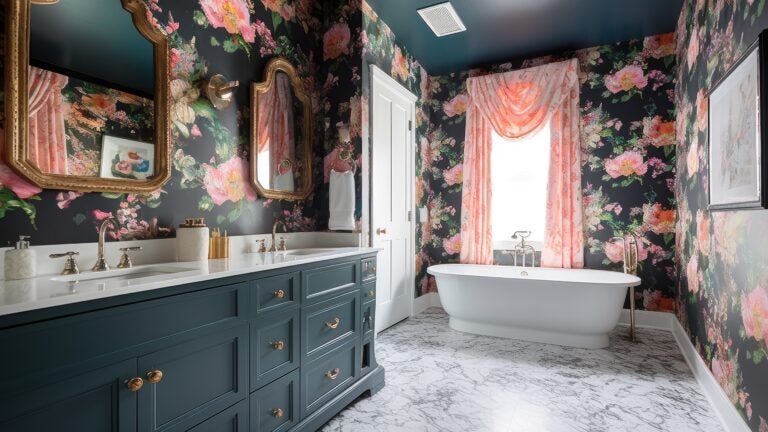Should you wallpaper a bathroom?

Home Improvement
Plus, how to deal with a tree root invasion in your sewer line. Send your questions to (protected email).

Can wallpaper withstand the humidity of a bathroom? Adobe Stock
Q. I am renovating two bathrooms that are rarely used. Three walls and the floor will be covered with marble tiles. I would like to cover the fourth wall with wallpaper made from a natural material like raffia or hemp. Will these materials resist moisture/steam from occasional shower use or possible splashes from the sink? Is there anything I can treat the wallpaper with to make it more water resistant?
LISA G.
A. We don’t often install wallpaper in bathrooms, but when we did it was no problem. Your question brings up something often overlooked: good bathroom ventilation. Most bathtub vents we replace during a remodel are woefully undersized. Ideally, you want to have a fan that can move 1 cubic foot of air per minute (CFM) per square foot of floor space. Most vents available that swing between 80 and 110 cfm and use a 4-inch vent line will work well. Large bathrooms that use a 150 cfm fan will need a 6-inch vent duct. Just as essential, set your ventilation on a timer. Too many people don’t pay attention to it. It is important, especially in your case, to leave the bathroom vent running for 10 to 15 minutes after you get out of the shower. Most people who only have a switch turn off the fan and go about their daily lives. These remnants of steam will persist and settle throughout the enclosed bathing space. This is an easy swap using existing wiring.
Q. Tree roots invaded our sewer line this year and two years ago. What is the best material to replace a sewer line? PVC was recommended, but my partner would prefer steel and/or hire an engineer to access the situation. What would you recommend, and if we go the engineer route, what type of engineer should we hire?
S.GORDON
A. It is possible these days to have your main sewer lines repaired without digging up your entire property. Often the main sewer lines we see beyond the foundation are essentially old clay pipes riddled with damaged roots and essentially skeletons of pipes buried decades ago. There are several technologies available today for relining “skeleton pipe” with PVC. It’s not cheap, but the excavation equipment, labor, etc. are expensive. nor are they for replacing it manually.
A potentially more cost-effective solution is to have the drain line cleaned annually. To some customers, we recommended that it be equipped with a camera to get an analysis of the condition of the drainage line. Often it is in good enough condition to have it cleaned every year to keep the roots at bay. This is a very simple process, usually costing hundreds of dollars. In most cases, you could do this for several decades and spend less than replacing or relining the main drainage line. As always, consult a qualified contractor, in this case a drain specialist. Your plumber may have good recommendations.
Mark Philben is the Project Development Manager at Charlie Allen Renovations in Cambridge. Send your questions to (email protected). Questions are subject to change.
Newsletter address
Get the latest news on home buying, selling, renting, designing and more.
Boston





